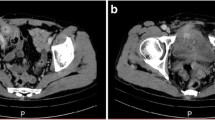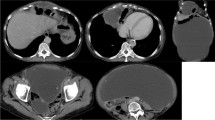Abstract
Giant pseudocyst formation of the anterior abdominal wall, following on-lay polypropylene mesh repair for incisional hernia is an under reported complication. We report an unusual case of a 56-year-old female who underwent a polypropylene mesh repair of incisional hernia 2 years back. Subsequently she developed a giant pseudocyst of the anterior abdominal wall, which was occupying the whole of the abdomen from the xiphisternum to the pubic bone, and over both the flanks. Over a period of one year, the cyst had defied multiple attempts at aspiration. The patient underwent a laparoscopic drainage of the collection with piecemeal excision of the entire cyst wall. Histopathology of the cyst wall revealed necrotic material with intervening areas of hemorrhage. No epithelial lining was seen. There has been no recurrence in the two years of follow-up. Conclusion: giant pseudocyst of the anterior abdominal wall is a rare complication following mesh repair of an incisional hernia. Such pseudocysts can be managed successfully by laparoscopic procedures.




Similar content being viewed by others
References
Arya N, Batey NR (1998) Pseudocyst formation after mesh repair of incisional hernia. J R Soc Med 1(12):647–9
Ogunbiyi SO, Morris-Stiff G, Sheridan WG (2004) Giant mature cyst formation following mesh repair of hernias: an underreported complication?. Hernia 8(2): 166–8
Ramachandran CS, Arora V (2000) Laparoscopic surgical management of giant post-traumatic lymphocele involving sacrum and the lower extremity. J Laparoendosc Adv Surg Tech A 10(6):341–5
Waldrep DJ, Shabot MM, Hiatt JR (1993) Mature fibrous cyst formation after Marlex mesh ventral herniorraphy: a newly described pathologic entity. Am Surg 59(11):716–8
Morris-Stiff GJ, Hughes LE (1998) The outcomes of non-absorbable mesh placed within the abdominal cavity: literature review and clinical experience. J Am Coll Surg 186(3):352–67
Gruessner RW, Fasola C, Benedetti E, Foshager MC, Gruessner AC, Matas AJ, Najarian JS, Goodale RL (1995) Laparoscopic drainage of lymphoceles after kidney transplantation: indications and limitations. Surgery 117(3):288–95
Marks J, Mouiel J, Katkhouda N, Gugenheim J, Fabiani P (1998) Laparoscopic liver surgery A report on 28 patients. Surg Endosc 12(4):331–4
Khoury G, Jabbour-Khoury S, Bikhazi K (1996) Results of laparoscopic treatment of hydatid cysts of the liver. Surg Endosc 10(1):57–9
Fallick ML, Long JP (1996) Laparoscopic marsupialization of lymphocele after laparoscopic lymph node dissection. J Endourol 10(6):533–4
Author information
Authors and Affiliations
Corresponding author
Rights and permissions
About this article
Cite this article
Mehrotra, P.K., Ramachandran, C.S., Goel, D. et al. Giant pseudocyst of the anterior abdominal wall following mesh repair of incisional hernia: a rare complication managed laparoscopically.. Hernia 10, 192–194 (2006). https://doi.org/10.1007/s10029-005-0025-7
Received:
Accepted:
Published:
Issue Date:
DOI: https://doi.org/10.1007/s10029-005-0025-7




